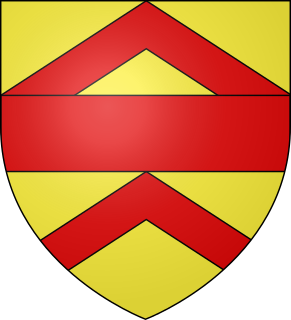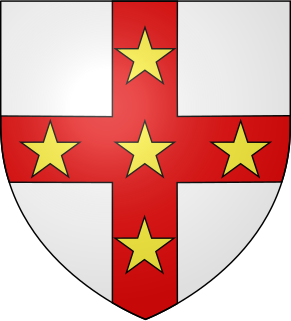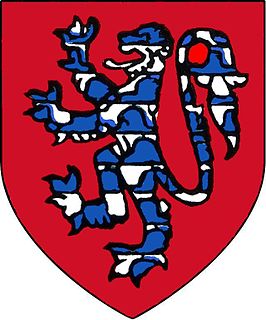Related Research Articles

Baron Mowbray is a title in the Peerage of England. It was created by writ for Roger de Mowbray in 1283. It was held for a long time by the Mowbray and Howard Dukes of Norfolk. The title was united with the Barony of Segrave in 1368, when John Mowbray, 1st Earl of Nottingham and 5th Baron Mowbray succeeded to that title. Then, it became united with the Dukedom of Norfolk. The two titles were frequently separated due to the attainders of the dukes of Norfolk, and were later reunited upon the dukes' restorations. The final separation occurred with the death of the ninth duke, when the barony of Mowbray fell into abeyance. Thereafter, it was united with the Barony of Stourton after it, and the barony of Segrave, were brought out of abeyance in the nineteenth century in favour of the twentieth Baron Stourton. The baronies of Mowbray and Segrave were shortly separated, as the barony of Segrave was called out of abeyance about two weeks after the barony of Mowbray. The Mowbray barons become premier barons of England when the only older title, that of the Barony of de Ros, is held by a woman.

Earl of Salisbury is a title that has been created several times in English and British history. It has a complex history, and is now a subsidiary title to the marquessate of Salisbury.

Baron Hastings is a title that has been created three times. The first creation was in the Peerage of England in 1290, and is extant. The second creation was in the Peerage of England in 1299, and became extinct on the death of the first holder in c. 1314. The third creation was in the Peerage of England in 1461, and has been in abeyance since 1960.

Baron FitzWalter is an ancient title in the Peerage of England. It was created on 24 June 1295 for Robert FitzWalter. The title was created by writ, which means that it can descend through both male and female lines. His great-grandson, the fourth baron, was an Admiral of the Fleet. The fourth baron's grandson, the sixth baron, died from dysentry at the siege of Harfleur. He was succeeded by his brother, the seventh baron, who in turn was succeeded by his daughter and only child, Elizabeth. She was the wife of John Radcliffe. Their son, the ninth baron, was attainted for treason in 1495 with his title forfeited. However, his son Robert Radcliffe obtained a reversal of the attainder by Act of Parliament in 1509 and later served as Lord Lieutenant of Lancashire. He was created Viscount FitzWalter in 1525 and Earl of Sussex in 1529. His grandson, the third earl, was summoned to the House of Lords through a writ of acceleration in 1553 in his father's junior title of Baron FitzWalter. Lord Sussex later served as Lord Deputy of Ireland. He was succeeded by his younger brother, the fourth earl. He had earlier represented Maldon, Hampshire and Portsmouth in the House of Commons and also served as Lord Lieutenant of Hampshire. When he died the titles passed to his only child, the fifth earl. He was Lord Lieutenant of Essex.
The title of Baron Grey of Codnor is a title in the peerage of England.
Baron Cromwell is a title that has been created several times in the Peerage of England. The first creation, which was by writ, was for John de Cromwell in 1308. On his death, the barony became extinct. The second creation came in 1375 when Ralph de Cromwell was summoned by writ to Parliament as Lord Cromwell. His grandson, the third baron, served as Lord High Treasurer to King Henry VI. However, on his death in 1455 the barony fell into abeyance between his nieces Maude and Joan. On Joan's death in 1490 the abeyance was terminated in favour of Maude, the fourth holder. When she died childless in 1497 the peerage once again fell into abeyance, this time between the daughters of the first baron. The title remained in abeyance for over 400 years. However, in 1922 the Committee for Privileges of the House of Lords reported in favour of the petition for the termination of the abeyancy of Selina Frances Bewicke-Copley. She was the daughter of Sir Charles Watson Copley, 3rd Baronet, and one of the co-heirs of Maud, daughter of the first baron Cromwell. Selina died in 1923 and in July of the same year the abeyance was terminated in favour of her son Robert Godfrey Wolesley Bewicke-Copley, who became the fifth baron. He notably served as Lord Lieutenant of Leicestershire. As of 2010 the ancient barony is held by his grandson, the seventh baron, who succeeded his father in 1982. Having lost his seat in the House of Lords under the House of Lords Act 1999, in April 2014 he was elected at a hereditary peers' by-election as a Crossbencher.

Baron Dudley is a title in the Peerage of England. It was created in circa 1440 for John Sutton, a soldier who served as Lord Lieutenant of Ireland. The title descended in the Sutton family until the 17th century when Frances Sutton, the heir apparent to the title, married Humble Ward, who, himself, was granted the title Baron Ward in 1644. Their heirs inherited both titles until 1740 when the differing rules of inheritance meant that the Barony of Dudley descended on Ferdinando Dudley Lea, who became the 11th Baron whilst the Barony of Ward went to John Ward, who later became 1st Viscount Dudley and Ward. On Ferdinando's death in 1757, the title fell into abeyance. The title was revived in 1916.

Baron Strange is a title that has been created several times in the Peerage of England. Two creations, one in 1295 and another in 1326, had only one holder each, upon the death of whom they became extinct. Two of the creations are extant. All four baronies of Strange have been created by writ, which means that they can pass through both male and female lines.

Baron le Despencer is a title that has been created several times by writ in the Peerage of England.
The title of Baron Welles has been created thrice. It was first created for Adam de Welles on 6 May 1299 in the Peerage of England by writ of summons. This creation was extinguished by attainder in 1469. It was created a second time in the Peerage of England by writ of summons for Sir Richard Hastings on 15 November 1482 and became extinct on his death. The third creation was on 8 January 1781, in the Peerage of Ireland, for Thomas Knox, later Viscount Northland. It is now a subsidiary title of the Earl of Ranfurly.
The title Baron Ferrers of Chartley was created on 6 February 1299 for John de Ferrers, son of Robert de Ferrers, 6th Earl of Derby. The daughter of the 6th Baron Ferrers of Chartley, Anne, married Walter Devereux who was summoned to parliament as Lord Ferrers in her right. Their descendants became Earls of Essex and the peerage was forfeited in 1601 on the attainder of Robert Devereux, 2nd Earl of Essex, but restored to his son Robert in 1604, on whose death in 1646 the peerage fell into abeyance. The abeyance was terminated in 1677 when Robert Shirley, a grandson of one of the sisters of the 3rd Earl of Essex, was summoned as Lord Ferrers of Chartley with precedence to the original creation. In 1711, Shirley was created the 1st Earl Ferrers, but the Earldom and Barony separated at his death, the barony going to Elizabeth Shirley, the daughter of his eldest son, while the earldom went to his second son. On the 1741 death of Elizabeth Shirley, 15th Baroness Ferrers of Chartley and wife of the Earl of Northampton, the peerage again briefly fell into an abeyance that was resolved in 1749 by the death of two of the three heiresses, leaving the surviving daughter, Charlotte Compton, wife of the Marquess Townshend, as 16th Baroness Ferrers of Chartley. The barony continued, merged with the marquessate, until the death of George Ferrars Townshend, 3rd Marquess Townshend in 1855, when it again fell into abeyance between his two sisters and their heirs. It remains in abeyance.

The title Baron Moels was created once in the Peerage of England, in 1299, and passed into abeyance with the death of the fourth lord in 1337. The four men who by modern usage are held to have been Barons Moels were:
The title Baron Multon de/of Egremont was created once in the Peerage of England. On 6 February 1299 Thomas de Multon was summoned to Parliament. On the death of the second baron, the barony fell into abeyance in 1334.

Baron St John of Basing is a former title in the Peerage of England. The family of St John of Basing in Hampshire and of Halnaker in Sussex was descended in the male line from the Norman Hugh de Port (d.1091) lord of the manor of Port-en-Bessin in Normandy who took part in the Norman Conquest of England in 1066, and was subsequently granted 53 manors in Hampshire. They had adopted the St. John surname by 1205.)

John Ap-Adam III, 1st Baron Ap-Adam was created baron by writ in 1299.

Baron Everingham is an abeyant title in the Peerage of England. It was created by Writ of summons to Parliament of Adam de Everingham of Laxton, Nottinghamshire, on 4 March 1309. It passed to his son Adam but fell into abeyance upon the death of his childless grandson Robert in 1371.
John III Lestrange, of Knockin in Shropshire, landowner, administrator and soldier, was a marcher lord defending England along its border with Wales.
Baron Vesci was a title in the Peerage of England and Peerage of the United Kingdom. It existed as a feudal barony by tenure, before being created by Writ of summons to Parliament of John de Vesci in 1264 until his death in 1289. It was created a second time by writ of William de Vescy in 1295 until his death in 1297. It was created a third time in 1313 by writ of William de Vesci until his death in 1314. The title was created a fourth time by writ of Henry Bromflete, Lord Vescy in 1449 until it became extinct in 1469 upon his death. The title was created a fifth time for John Vesey, 4th Viscount de Vesci in 1884 until his death in 1903 when the title became extinct.
Baron FitzReginald was a title in the Peerage of England. It existed as a feudal barony by tenure, before being created by Writ of summons to Parliament of John FitzReginald in 1294 until his death in 1310, when the title became extinct.
Baron Clavering was a title in the Peerage of England. It existed as a feudal barony by tenure, before being created by Writ of summons to Parliament of Robert fitzRoger, as Baron FitzRoger in 1295 until his death in 1310. His son John de Clavering, was created by writ of summons to Parliament as Baron Clavering in 1299 until his death in 1332.
References
- ↑ Nicolas, Nicholas Harris (1825). A synopsis of the peerage of England exhibiting, under alphabetical arrangement, the date of creation, descent and present state of every title of peerage which has existed in this country since the conquest. London: J. Nichols and son. p. 22.
| This history article is a stub. You can help Wikipedia by expanding it. |